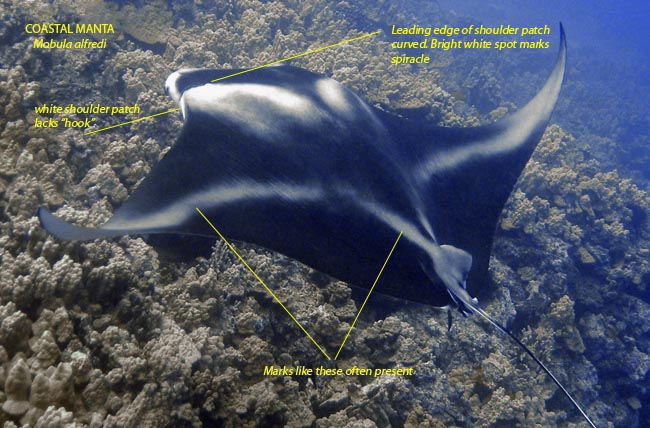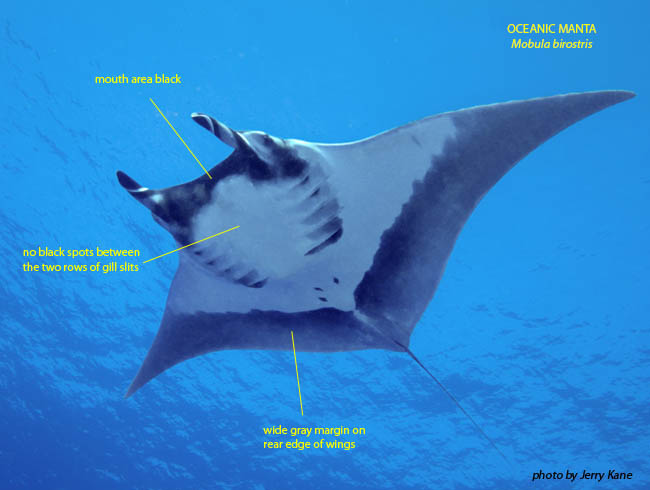MANTA
RAY UPDATE It's
official, there are now two manta ray species in Hawaii!
According to a 2009
paper by Andrea D. Marshall, Leonard J.V. Compagno, and Michael B. Bennett,
the previous genus Manta consisted of at least two species, both
of which are present in Hawai`i. The common coastal species, previously
called Manta birostris, was changed to Manta alfredi. The
less common oceanic species remained Manta birostris. However,
the genus name Manta has now been changed to Mobula. Thus
the current scientific names for these two rays are Mobula alfredi
and Mobula birostris.

OCEANIC MANTA Mobula birostris (Walbaum, 1792)
Only occasionally reported in Hawaiian waters, this manta seems to be
more pelagic in its habits than the Coastal Manta. (One individual, for
example, was photographed off Kona in 2006 and later off Maui in 2009.
No one knows where it was between the two sightings.) Characters for field
identification are: 1) Bright white shoulder patches are always present
and usually have a backward facing "hook" on outer side .
2) Front edge of white shoulder patch is parallel with front edge of
mouth. 3) No black spots or marks occur in the "chest"
area between the two pairs of gill slits on the underside. 4) A
wide gray margin always present along rear edge of the wings on the underside.
5) The mouth area is dark gray or black (best seen from below or
when viewed head-on). In addition, there is a small spine at the base
of the tail which is almost completely embedded in a knoblike bony mass,
difficult to see underwater. A few individuals are all black except for
a white blaze in center of underside. This is the largest manta, attaining
at least 24½ ft. wingtip to wingtip.
COASTAL MANTA
Mobula alfredi (Krefft, 1868)
This by far the most commonly-seen of Hawaii's two manta species. it generally
remains within a mile or so of shore and is not known to travel from island
to island. Characters for field identification are: 1) Pale to white
shoulder patches usually present, always with a small bright white spot
on the leading edge (marking the spiracle, or opening where water is drawn
into the gills). 2) Black spots or markings are almost always present
in the "chest" area between the two pairs of gill slits on the
underside. 3) The mouth area is whitish or grayish (best seen
from below or when viewed head-on). In addition, there is no spine at
the base of the tail. (This character is not detectable except perhaps
at very close range.) A few individuals are entirely black except for
a white blaze mark on the underside. Manta alfredi grows to a maximum
of about 18 ft. from wingtip to wingtop. It occurs throughout the Indo-Pacific,
but is not recorded from the Eastern Pacific. All the manta photos in
my books are Coastal Mantas.
For more information, see:
Marshall, A.D., L.J.V. Compagno, M.B. Bennett, 2009. Redescription of the genus Manta with resurrection of Manta alfredi (Krefft, 1868) (Chondrichthyes; Myliobatoidei; Mobulidae) Zootaxa 2301: 1-28 (2009)



